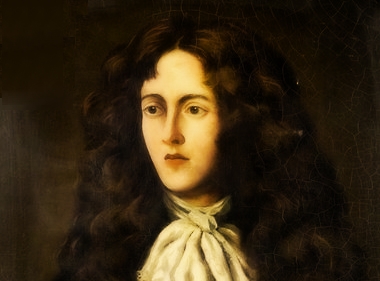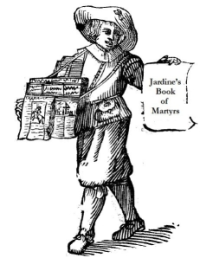The Beginning of the Argyll Rebellion and the end of the Killing Times: A Letter to Claverhouse

Soon after the Argyll Rising broke out, the privy council wrote to Colonel John Graham of Claverhouse on 23 May, 1685. Their letter lays out the general disposition of the regime’s forces after Argyll landed at Campbeltown at the southern end of the Kintyre peninsular on 20 May.
Its importance for the history of the Killing Times lies in the locations it provides for key commanders of government forces – Claverhouse, Colonel Douglas and Lt-General Drummond – at the end of the most violent period of repression, which took place in first weeks of May.
The text of the letter is as follows:
‘Sir, The Lord Comissioner [Queensberry] shewd your letter. If there be any danger by horse, it must be from the Border [from Monmouth’s supporters in England]; so propose what you judge expedient, and writt it to the E[arl]. of Dumbarton.
The army is thus posted: the foot and horse and dragoons, which went with Lt. Gen[era]ll. [William] Drummond and Coll[one]1. [James] Douglas, are at or near Air; what can be spared from this will go thither also.
The militia, which rendezvouses at [Lin]Lithgow, are to be posted at Glasgow, till they be put in order. Marq[ui]s. of Athole will have above 3000 in Argyleshyr; the Marq[ui]s. of Huntly some more at Loch Ness head, but not so soon, Athole being already into Argyl.
Charles Campbell, soune to Argyle, is levying in Argyle; some heritors, and towards 300 comons have joined him.
Argyle keeps the sea with 5 ships: the frigots will be with him shortly.
The King hath sent comissiones to Col[one]l. [James] Dowglas and yow [on 18 May], as Brigadiers both of horse and foot; Douglas is prior in date [i.e., 16 May].
Ships by both seas are coming on Argyle; and some armes both for horse and foot are comeing hither [to Edinburgh] by a yacht [from England].
Wee hear that about 30 horsmen came over the border, and returned in few hours. Wee have writt to Feilding, who is deputy governour of Carlyle [in England], to correspond with you, and wee desyre you may with him. Lett us hear frequently, and you shall have still returns from,
Sir,
Your affectionat friends and servants,
Edin[burgh]. 23 May, 1685
[Earl of] DUNBARTON.
[Duke of] QUEENSBERRY, Com[missione]r.
[Viscount] TARBAT.
[Earl of] PERTH, Cancell[or].
[p.s.] Hast[e] Feelding’s letter to him.
For his Majesties speciall service.
For Colonell Grahame of Clevres.’
The letter establishes that Lieutenant-General William Drummond and Colonel James Douglas were ‘at or near’ Ayr at the end of the most violent period of repression. That suggests that Drummond may have been involved in the deaths of the Barrhill martyrs and Alexander Linn earlier in May, as he was also in central Ayrshire on c.6 May. However, the Barrhill killings took place in the deep south of the shire, close to the march boundary with Galloway. Other evidence suggests that those killings took place far later. Drummond is recorded in the vicinity of the killings when he interrogated prisoners at Barr Kirk, apparently in early to mid July.
Where Claverhouse was located on 23 May is not made clear in the letter, but, from the instructions given to him, he must have been in the Border area, probably somewhere in Dumfriesshire. The presence of Claverhouse near the Border suggests that he separated from Drummond’s force in early May and that the killing of Daniel McIlwraith by his men far to the west in Carrick may have taken place either before May, or later in, 1685.
The letter also establishes that the earl of Dumbarton had arrived from London and was still in Edinburgh on 23 May, which makes it almost certain that he could not have been involved in the cases of the Mauchline martyrs, who are said to have been hanged on 6 May.
Additional Text © Copyright Dr Mark Jardine. All Rights Reserved.
Related
~ by drmarkjardine on April 1, 2012.
Posted in 1685, Argyll Rising, Ayrshire, Colonel James Douglas, Daniel McIlwraith (d.1685), Dragoons, Dumfriesshire, earl of Argyll, earl of Perth, George Douglas earl of Dumbarton, Highlanders, John Graham of Claverhouse, Linlithgow, Lt General William Drummond, Monmouth Rising, Scotland, Scottish History, William Douglas duke of Queensberry
Tags: Britain, British History, Covenanters, earl of Argyll, History, Scotland, Scottish History
4 Responses to “The Beginning of the Argyll Rebellion and the end of the Killing Times: A Letter to Claverhouse”
Leave a reply to On The Trail of Claverhouse: The Killing of Matthew MacIlwraith in 1685 #History #Scotland | Jardine's Book of Martyrs Cancel reply
This site uses Akismet to reduce spam. Learn how your comment data is processed.


[…] appears that Claverhouse remained close to the Border after he was ordered there in May. On 11 or 12 May, Claverhouse had been involved in the summary execution of Andrew […]
John Graham of Claverhouse on the departure of the Highlanders in 1685. | Jardine's Book of Martyrs said this on October 17, 2013 at 12:28 pm |
[…] had been at Ayr at some point after a letter to him of 23 May, probably in early-to-mid June. He had then rode east via Sanquhar to Ballaggan in Durisdeer parish […]
A Clue to the Killing Times: John Graham of Claverhouse on the Earl of Annandale, 16 June, 1685 | Jardine's Book of Martyrs said this on October 19, 2013 at 10:05 am |
[…] Douglas then vanishes from the record until 23 May, when he was at or near Ayr with the forces of the Scottish Army arrayed against the Argyll […]
A Bullet From The General: The Shooting of Adam Macquhan by a Hero of the Battle of the Boyne | Jardine's Book of Martyrs said this on March 21, 2016 at 2:30 pm |
[…] summery execution of Andrew Hislop in Eskdalemuir parish. On 23 May, he may have still in that area when the privy council sent him instructions to correspond with an English officer at […]
On The Trail of Claverhouse: The Killing of Matthew MacIlwraith in 1685 #History #Scotland | Jardine's Book of Martyrs said this on December 30, 2016 at 1:56 pm |